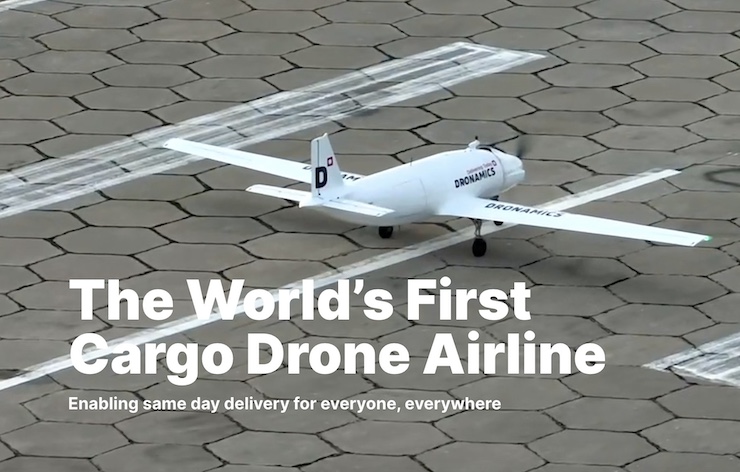
© Dronamics
How do national postal services reach their customers living on remote, often difficult-to-reach islands? Often with great difficulty – and indeed, sometimes just sporadically. While governments are generally mandated by law to provide their citizens with regular mail delivery , weather and marine conditions can frequently intrude to delay and even derail ongoing postal service. Ferries may be forced ashore by rough seas and manned aircraft may be grounded for days and even weeks by heavy rain, wind and fog conditions.
Island residents, who are heavily dependent on air and sea deliveries for most of their necessities, have learned to put up with these constant interruptions – but often at great sacrifice. In recent months, a number of countries have decided to address this shortfall – by turning to drones.
The latest country to do so is Greece, where a partnership between its national postal service. ELTA, and Dronamics, reputedly the leading cargo delivery drone company in Europe, is about to get underway.
Dronamics is the manufacturer of the “Black Swan,” one of largest and most versatile cargo drones currently on the market. The plane requires only 400 meters to land and take off, which makes it ideal for reaching remote and underserved areas where traditional airport infrastructure is missing or underdeveloped. Because it’s remotely piloted – or potentially autonomous – the human safety considerations associated with manned aircraft are rendered moot. The plane is sturdy enough to withstand heavy winds and rain, and with digital onboard flight programming, it can easily fly through fog.
Dronamics and ELTA plan to begin operations next year focusing on Greek islands to the south of the mainland – all told, there are 300 inhabited Greek islands of various sizes that could eventually be targeted with drone deliveries, ELTA officials say. But the larger plan is to link Athens, the capital, to remote mainland towns in the north where road vehicles also encounter difficulties making regular mail delivery.
Eventually, with EASA regulatory approval, the plan is to extend the entire operation to postal and package deliveries between Athens and other major European cities, ELTA and Dronamics officials say.
A similar ambition is apparent in the UK, where the British Royal Mail is planning to partner with Skyports to field 500 drones for regular mail delivery as part of the 185-mile drone corridor across central England known as “Project Skyway.” For now, the UK service is focusing on mail deliveries to remote islands off of Britain’s northern and southern coasts. Deliveries to the Orkneys, part of Scotland, have already gotten underway, with great success, according to local reports.
Another mail drone pioneer is South Korea. The country’s western and southern coastlines are dotted with hundreds of small sparsely populated islands. Last December, a state post office on Wonsan Island, about140 kilometers south of Seoul, began testing mail deliveries to seven nearby islands. The drones made short delivery runs to each, then returned to their base camp on Wonsan. South Korean postal officials are reviewing the results of the effort and plans to formalize the delivery system later this year. Other island mail systems are also under consideration, officials say.
In the United States, talk of a possible national mail drone service first surfaced back in 2019, when the USPS put out an RFP requesting bids from contractors for feasibility studies – but the idea appears to have died – for now. Lawrence, a small town in Indiana, did establish a pilot mail drone delivery service with the support of Dronedek in collaboration with local postal authorities, but no significant follow-up occurred.
Elsewhere in the world, however, the idea continues to spread. Last month, Dronamics inked a deal with the Emirates Post Group (EPG), the national postal service in the United Arab Emirates (UAE). Dronamics and EPG plan to conduct proof-of-concept flights in the region’s expanding “smart drone” hub in Abu Dhabi with at least one drone aircraft by 2024. Assuming success, EPG and Dronamics will extend the service to the rest of the UAE in 2025.
It’s important to note that none of these new mail drone operations will completely replace the need for additional mail delivery support. Unlike private cargo services, including UPS and FedEx, that might deliver mail and other packages to customer doorsteps, government-sponsored mail drones will conduct “middle mile” deliveries with the last mile to be managed by local post offices. The drones will deliver the mail to a central reception center, and either be picked up there by mail customers or delivered to their homes by road vehicles or by foot. Still, the cost and time savings will be immense.
Some critics have expressed skepticism that a regular national mail service could ever be managed entirely by drones, largely because of the logistical and safety problems associated with drone flights in dense urban communities. That may be, but for now, island residents in some parts of the world are receiving a fresh assurance that indeed, thanks to drones, their “mail will get through.” And once the news catches on, the demand for regular, low-cost and sustainable mail delivery by drone — even here in the US, where post offices face closures and budget cutbacks – will likely spread quickly.
|